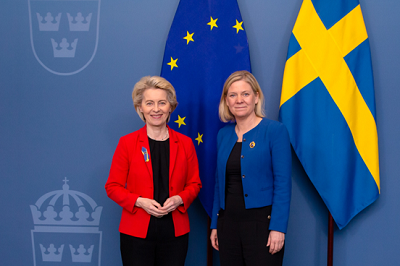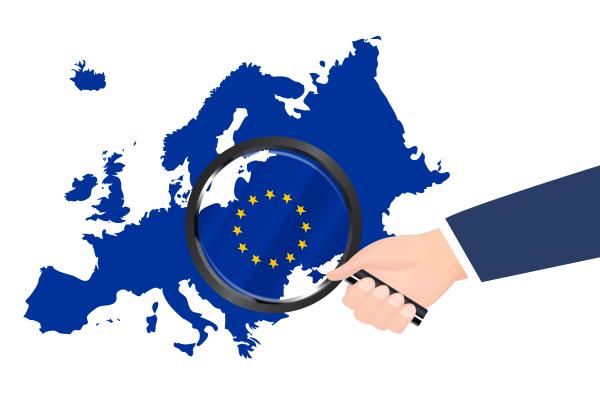Following the unprecedented crisis caused by the COVID-19 pandemic, Sweden’s recovery and resilience plan has responded to the urgent need to foster a strong recovery, while making Sweden’s economy and society more resilient and future ready. In response to the energy market disruption caused by Russia's invasion of Ukraine, the Commission launched the REPowerEU Plan. The Recovery and Resilience Facility is at the heart of its implementation and its funding. Under REPowerEU, EU countries are updating their recovery and resilience plans with new measures to save energy and diversify the EU’s energy supplies.

Green transition
Focusing on green technologies and capacities - sustainable mobility, energy efficiency and renewables, climate change adaptation; circular economy; and biodiversity.
Policies for the next generation
Improving access to and the quality of general, vocational, and higher education; focusing on digital education, early childhood education and care; supporting youth employment.
Smart, sustainable, inclusive growth
promoting entrepreneurship, competitiveness, industrialisation; improving the business environment; fostering research, development and innovation, supporting small- and medium-sized businesses.
Digital transformation
Promoting the roll-out of very high-capacity networks, the digitalisation of public services, government processes, and businesses, in particular SMEs; developing basic and advanced digital skills; supporting digital-related R&D and the deployment of advanced technologies.
Social and territorial cohesion
Improving social and territorial infrastructure and services, including social protection and welfare systems, the inclusion of disadvantaged groups; supporting employment and skills development; creating high-quality, stable jobs.
Health and economic, social and institutional resilience
Improving the resilience, accessibility and quality of health and long-term care, including measures to advance their digitalisation; increasing the effectiveness of public administration systems.
The map exclusively serves information purposes and is not an exhaustive database of projects supported by the Recovery and Resilience Facility. It does not reflect the distribution of the projects funded by the Recovery and Resilience Facility across the European Union, nor across different geographical areas or sectors within EU Member States. The RRF funding amounts shown for measures are based on the initial cost estimates included in the recovery and resilience plans.
Furthermore, the projects showcased are without prejudice to any future assessment by the Commission in the context of verifying the satisfactory fulfilment of milestones and targets under Regulation (EU) 2021/241 establishing the Recovery and Resilience Facility.
Country snapshot

The country snapshot illustrates some of the most iconic and impactful projects included in the Swedish Recovery and Resilience Plan that will bring positive change for EU citizens, businesses and the EU at large.
The reforms and investment in Sweden’s plan, approved by Council on 4 May 2022, are helping it become more sustainable, resilient and better prepared for the challenges and opportunities offered by the green and digital transitions. Following Council approval of Sweden’s plan on 09 November 2023, Sweden’s recovery and resilience plan was updated on 09 November 2023 also to introduce a REPowerEU chapter.
*This value includes also the part of the plan which is financed with national resources
- 14 investment streams and 16 reforms
- 44% of the plan will support climate objectives
- 21% of the plan will foster the digital transition.
The transformative impact of Sweden’s plan is the result of a strong combination of reforms and investments which address the country’s specific challenges. The implementation of the measures is expected to bring about structural change in the economy and society by enhancing its environmental sustainability and digitalisation and fostering skills. A key measure in the plan is the Climate Leap investment scheme, which shall finance local and regional activities to reduce emissions of carbon dioxide and other gases affecting the climate, which should accelerate the green transformation of the economy. This is further accentuated through the promotion of innovative technologies for fossil-free solutions in energy-intensive industries. The measures to support for broadband network roll-out will help improve access to high-speed connections in sparsely populated areas. By improving the skills of staff in elderly care centres, the plan will contribute to the welfare of older people and thus help improve social cohesion. All measures have to be implemented within a tight time frame, as the Regulation establishing the Recovery and Resilience Facility requires all milestones and targets within the national plans to be completed by August 2026.
REPowerEU measures in Sweden’s plan
Sweden’s plan now includes three new measures in line with REPowerEU's objectives.
To finance this increased ambition, Sweden has asked for a share of its Brexit Adjustment Reserve to be transferred to the plan, amounting to €66 million. These funds would be added to Sweden's REPowerEU grant of €198.4 million.
Key measures for REPowerEU
The REPowerEU measures include one reform and the scale-up of two existing investments.
The new reform aims at speeding up the authorisation process for the construction of electricity grids.
The two scaled up investments aim at improving energy efficiency in multi-dwelling buildings, rental dwellings and student housing
Together, these measures are expected to contributes both to the electrification of the Swedish economy and to increase further Sweden’s energy efficiency
The support scheme for investments aims at improving energy efficiency in multi-dwelling buildings. The investment will not only promotes energy efficiency through increased energy performance but will also reduce energy demand and greenhouse gas emissions.
Green transition
Sweden has set an ambitious target of achieving carbon neutrality by 2045.
Substantial reforms and investments are required to put the country on track towards the achievement of this goal. This concerns in particular the sectors that currently have the highest emissions including energy, housing, transport and industry.
Key measures for the green transition
- Sweden’s recovery and resilience plan supports the green transition through investments of €811 million in local and regional climate investment, including projects to reduce greenhouse gas emissions through the conversion to bioenergy for heating in industry.
- €286 million will be allocated to climate investment in the industrial sector, projects that develop and implement new technology with zero, low or negative emissions of greenhouse gases in industries with high process emissions.
- €247 million will be invested in protecting valuable nature in areas that host high natural values by establishing formally protected areas of nature reserves.
- On green transportation, €148 million will be invested in strengthening support to improve railway capacity.
- The plan includes a reform incentivising decarbonisation of transport, by abolishing the reduction of energy tax on fuel and adjusted taxable benefit rates for company cars.
The modified plan keeps a strong focus on the green transition, allocating 43.6% of the available funds to measures that support climate objectives, which is well above the objective of 37 %.

More than 60 km of Swedish railways were upgraded and 6 switches were replaced on the on the Gävle-Åänge route.
- Project locations
- Sweden
Digital transition
Digital challenges for Sweden focus on the need to realise the transformative potential of digitalisation, including broadband network roll-out and increased numbers of study places in higher vocational education to address the current scarcity of experts in the Information and Communication Technology sector. In addition, the Swedish plan contains investments to scale-up the education at universities and other higher education institutions.
Key measures for the digital transition
- Sweden’s recovery and resilience plan supports the digital transition with a set of investments and reforms.
- Digital connectivity is supported with €464 million in accelerating broadband network roll-out in sparsely populated areas.
- Digitalisation of public administrations is supported with €21 million in upgrading digital services in public administration, including a joint digital infrastructure.
- The plan envisages a €42 million support for digital skills by increasing digital skills at universities and other higher education institutions.
The modified plan has further strengthened the focus on the plan on the digital transition, devoting 21.2% of the available funds to measures that support digital objectives (up from 20,5% in the original plan).
Economic and social resilience
Key macro-economic challenges for Sweden’s economy include addressing challenges emanating from high household debt and a malfunctioning housing market, and structural long-term unemployment. Efforts are needed to upgrade skills in segments of the labour market to match market demands as well as to reduce educational gaps and enhance labour market integration.
Key measures in reinforcing economic and social resilience
- The plan reinforces economic and social resilience by allocating €196 million to improving employability by expanding vocational training at upper secondary level.
- The plan invests €308 million in scaling up education at universities and other higher education institutions to tackle the challenges in the labour market.
- The plan allocates €452 million to improving elderly care by upskilling and training of staff working in elderly care centres and €296 million to increasing the supply of new rental dwellings with a lower rent to relief the housing shortage.
- A reform gradually increases the average retirement age to improve further the sustainability of the public pension system and the plan includes measures to improve the fight against money laundering and terrorist financing, including through strengthening the Financial Supervisory Authority.

More than 68,000 new places have been created in regional adult vocational education.
- Project locations
- Sweden
ANNUAL EVENTS
Annual events facilitate the exchange of views on the state of implementation of the Recovery and resilience plans, while ensuring close cooperation between all stakeholders and providing a platform to discuss interlinks between the Plans and other Union programmes.
More information on Annual events held in Sweden can be found here
EUROPEAN SEMESTER
Sweden’s plan is consistent with relevant country-specific challenges and priorities identified in the European Semester, the annual cycle of coordination and surveillance of the EU’s economic policies. For a detailed explanation of the European Semester see the following link: The European Semester explained | European Commission (europa.eu)
National recovery and resilience website
Original Recovery and Resilience Plan (May 2022)
National recovery and resilience plan
Updated Recovery and Resilience Plan (November 2023)
Addendum to Sweden´s Recovery and Resilience plan
Original Recovery and Resilience Plan (May 2022)
Documents
Commission Staff Working Document: Analysis of the recovery and resilience plan of Sweden
Press Material
Press release: "European Commission endorses Sweden's plan"
Factsheet: Sweden’s recovery and resilience plan
Questions and answers: European Commission endorses Sweden's plan
Updated Recovery and Resilience Plan (2023)
Documents
Press Material
Further Information
Presentation to the Council of Sweden’s recovery and resilience plan
Summary of the assessment of the Swedish recovery and resilience plan
Updated Recovery and Resilience Plan (2024)
Documents


